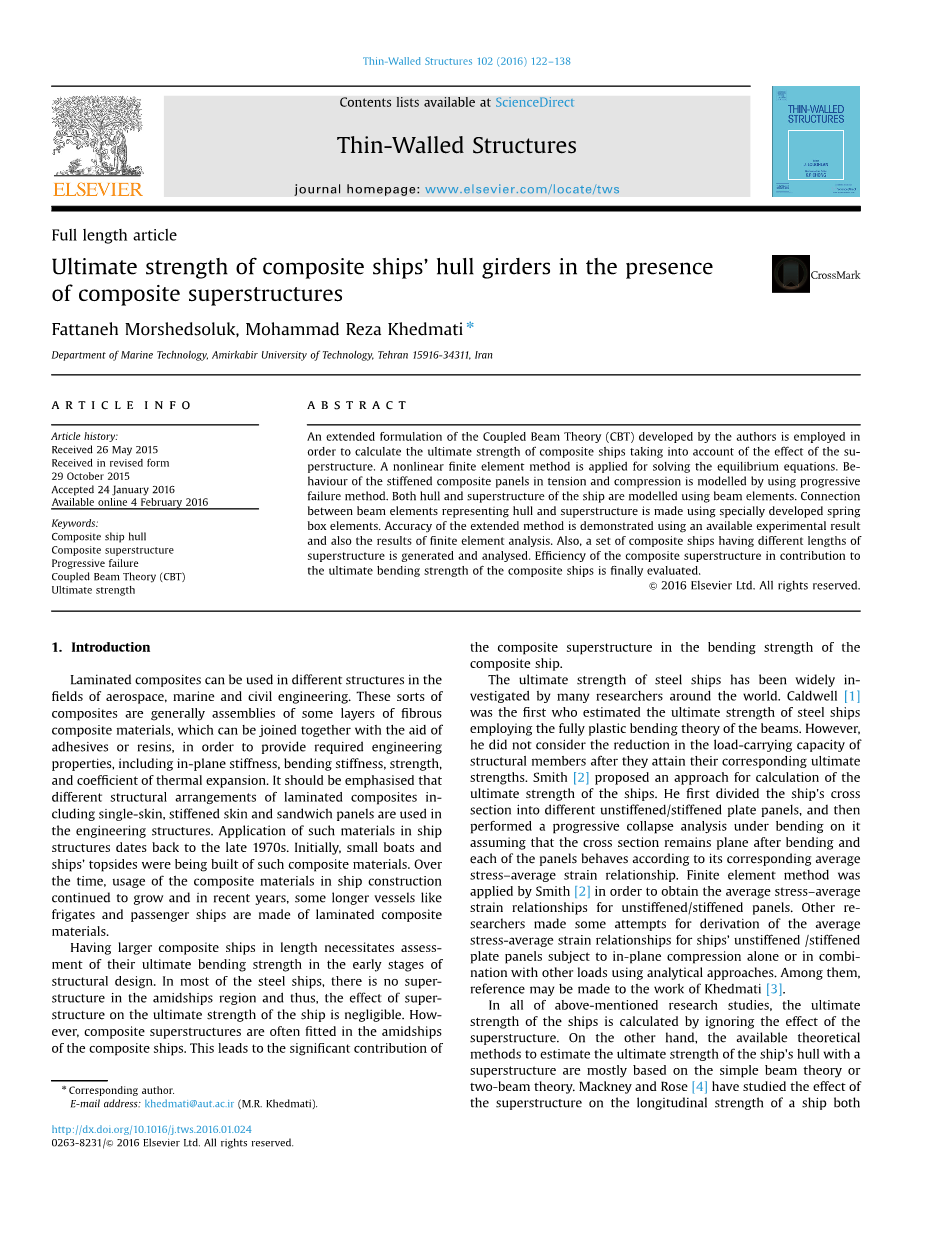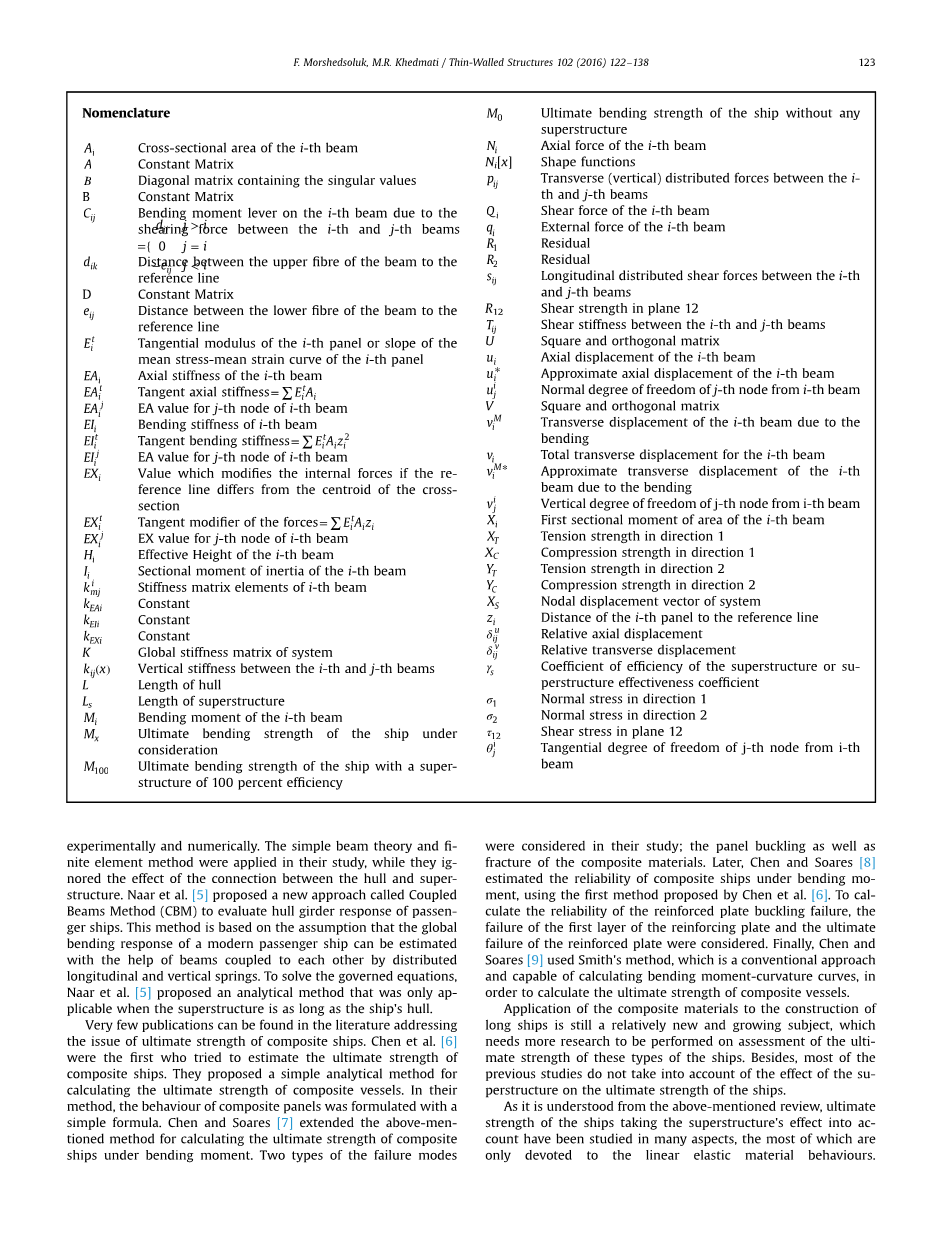Laminated composites can be used in different structures in the fields of aerospace, marine and civil engineering. These sorts of composites are generally assemblies of some layers of fibrous composite materials, which can be joined together with the aid of adhesives or resins, in order to provide required engineering properties, including in-plane stiffness, bending stiffness, strength,and coefficient of thermal expansion. It should be emphasised that different structural arrangements of laminated composites including single-skin, stiffened skin and sandwich panels are used in the engineering structures. Application of such materials in ship structures dates back to the late 197 s. Initially, small boats and shipsrsquo; topsides were being built of such composite materials. Over the time, usage of the composite materials in ship construction continued to grow and in recent years, some longer vessels like frigates and passenger ships are made of laminated composite materials.
层压复合材料可用于航空航天、海洋工程和土木工程领域的不同结构。 这些复合材料通常是一些纤维层的组装体复合材料,可以借助粘合剂或树脂连接在一起,以提供所需的工程性能,包括面内刚度、弯曲刚度、强度,和热膨胀系数。 应当强调的是,在工程结构中使用包括单层,加强外板和夹层板的层压复合材料的不同结构布置。 这种材料在船舶结构中的应用可追溯到2 世纪7 年代末。 最初,这些复合材料被用来建造小船和船只的顶部。 随着时间的推移,近年来复合材料在船舶建造中的使用量持续增长,一些更长的船只比如护卫舰和客船由采用层压复合材料建造。
Having larger composite ships in length necessitates assessment of their ultimate bending strength in the early stages of structural design. In most of the steel ships, there is no superstructure in the amidships region.and thus, the effect of superstructure on the ultimate strength of the ship is negligible. However, composite superstructures are often fitted in the amidships of the composite ships. This leads to the significant contribution of the composite superstructure in the bending strength of the composite ship.
长度较大的复合材料船需要在结构设计的早期阶段评定其极限弯曲强度。在大多数钢质船舶中,船中区域没有上层建筑。因此,上层建筑对船舶极限强度的影响可以忽略不计。 但是,复合上层建筑通常安装在复合船的船中处。导致复合上层结构对复合材料船的弯曲强度有着显著的影响。
The ultimate strength of steel ships has been widely investigated by many researchers around the world. Caldwell was the first who estimated the ultimate strength of steel ships employing the fully plastic bending theory of the beams. However,he did not consider the reduction in the load-carrying capacity of structural members after they attain their corresponding ultimate strengths. Smith proposed an approach for calculation of the ultimate strength of the ships. He first divided the ship#39;s cross section into different unstiffened/stiffened plate panels, and then performed a progressive collapse analysis under bending on it assuming that the cross section remains plane after bending and each of the panels behaves according to its corresponding average stress-average strain relationship. Finite element method was applied by Smith in order to obtain the average stress-average strain relationships for unstiffened/stiffened panels. Other researchers made some attempts for derivation of the average stress-average strain relationships for shipsrsquo; unstiffened /stiffened plate panels subject to in-plane compression alone or in combi-nation with other loads using analytical approaches. Among them,reference may be made to the work of Khedmati .
世界各地的许多研究人员已经广泛研究了钢质船舶的极限强度。Caldwell是第一个使用梁的全塑性弯曲理论来估算钢质船的极限强度的人。然而,他并没有考虑到结构构件在达到其相应的极限强度后承载能力会降低。Smith提出了一种计算船舶极限强度的方法。他首先将船的横截面划分为不同的非加筋板和加筋板面板,然后在其弯曲下进行渐进式破坏分析,假定横截面在弯曲后保持平面,并且每个面板的性能根据其相应的平均应力和平均应变关系表现。 Smith用有限元方法得到了非加筋/加筋板的平均应力和平均应变关系。其他研究人员尝试推导船舶非加筋/加筋平板的平均应力和平均应变关系,这些平板受单独或与其他荷载结合使用分析方法进行平面内压缩。其中可以参考Khedmati的工作。
In all of above-mentioned research studies, the ultimate strength of the ships is calculated by ignoring the effect of the superstructure. On the other hand, the available theoretical methods to estimate the ultimate strength of the ship#39;s hull with a superstructure are mostly based on the simple beam theory or two-beam theory. Mackney and Rose have studied the effect of the superstructure on the longitudinal strength of a ship both experimentally and numerically. The simple beam theory and finite element method were applied in their study, while they ignored the effect of the connection between the hull and superstructure. Naar et al. proposed a new approach called Coupled Beams Method (CBM) to evaluate hull girder response of passenger ships. This method is based on the assumption that the global bending response of a modern passenger ship can be estimated with the help of beams coupled to each other by distributed longitudinal and vertical springs. To solve the governed equations,Naar et al. proposed an analytical method that was only applicable when the superstructure is as long as the ship#39;s hull.
在所有上述研究中,船舶的极限强度是通过忽略上层建筑的影响来计算的。另一方面,用上层建筑估算船体极限强度的理论方法主要基于简单梁理论或双跨梁理论。麦克尼和罗斯已经通过实验和数值研究了上层建筑对船舶纵向强度的影响。在他们的研究中应用简单梁理论和有限元的方法,而忽略了船体与上层建筑之间的连接。Naar等人提出了一种称为耦合梁法(CBM)的新方法来评估客船的船体梁响应。该方法基于这样的假设:现代客船的整体弯曲响应可以通过分布式纵向和垂直弹簧相互耦合的梁的帮助来估计。为了解决受控方程,Naar等人提出了一种只有当上层建筑和船体一样长时可以使用的分析方法。
Very few publications can be found in the literature addressing the issue of ultimate strength of composite ships. Chen et al. [6]were the first who tried to estimate the ultimate strength of composite ships. They proposed a simple analytical method for calculating the ultimate strength of composite vessels. In their method, the behaviour of composite panels was formulated with a simple formula. Chen and Soares [7] extended the above-mentioned method for calculating the ultimate strength of composite ships under bending moment. Two types of the failure modes were considered in their study; the panel buckling as well as fracture of the composite materials. Later, Chen and Soares [8]estimated the reliability of composite ships under bending moment, using the first method proposed by Chen et al. [6]. To calculate the reliability of the reinforced plate buckling failure, the failure of the first layer of the reinforcing plate and the ultimate failure of the reinforced plate were considered. Finally, Chen and Soares [9] used Smith#39;s method, which is a conventiona
全文共25962字,剩余内容已隐藏,支付完成后下载完整资料


英语原文共 17 页,剩余内容已隐藏,支付完成后下载完整资料
资料编号:[13999],资料为PDF文档或Word文档,PDF文档可免费转换为Word


